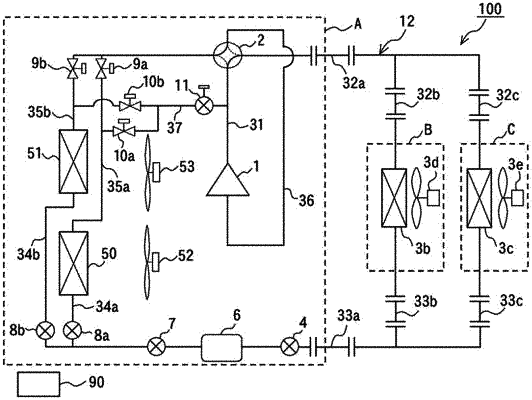| CPC F24F 11/84 (2018.01) [F24F 1/0068 (2019.02)] | 13 Claims |

|
1. An air-conditioning apparatus including an outdoor unit and an indoor unit connected to the outdoor unit with pipes interposed therebetween, the air-conditioning apparatus comprising:
a main circuit in which a compressor, a load side heat exchanger included in the indoor unit, a first pressure reducing device, and a plurality of parallel heat exchangers included in the outdoor unit and connected in parallel with each other are sequentially connected by the pipes and through which refrigerant circulates;
a bypass pipe diverting a portion of the refrigerant discharged from the compressor and causing the portion of the refrigerant to flow into the parallel heat exchangers;
a flow path switching device provided at the bypass pipe and selecting one or more parallel heat exchangers out of the plurality of parallel heat exchangers as a target to be defrosted;
a flow control device provided at the bypass pipe and adjusting an amount of flow of the refrigerant flowing in the bypass pipe; and
a controller configured to control operation of the outdoor unit and the indoor unit, wherein
the controller is configured to operate in a heating normal operation mode for causing each of the plurality of parallel heat exchangers to function as an evaporator and a heating-defrosting operation mode for treating the one or more parallel heat exchangers out of the plurality of parallel heat exchangers as the target to be defrosted and causing each other parallel heat exchanger out of the plurality of parallel heat exchangers to function as an evaporator, and
in a case of switching from the heating normal operation mode to the heating-defrosting operation mode, the controller is configured to make a selection from an initial control mode 1 and an initial control mode 2 to execute the heating-defrosting operation mode, wherein
in the initial control mode 1, control is performed such that an initial frequency of the compressor is set to a predetermined maximum frequency and an initial opening degree of the flow control device is set to an opening degree lower than a predetermined maximum opening degree, and
in the initial control mode 2, control is performed such that the initial opening degree of the flow control device is set to the predetermined maximum opening degree and the initial frequency of the compressor is set to a frequency lower than the predetermined maximum frequency, to execute the heating-defrosting operation mode, and
the controller selects either the initial control mode 1 or the initial control mode 2 based on a frequency of the compressor in the heating normal operation mode.
|
|
13. An air-conditioning apparatus including an outdoor unit and an indoor unit connected to the outdoor unit with pipes interposed therebetween, the air-conditioning apparatus comprising:
a main circuit in which a compressor, a load side heat exchanger included in the indoor unit, a first pressure reducing device, and a plurality of parallel heat exchangers included in the outdoor unit and connected in parallel with each other are sequentially connected by the pipes and through which refrigerant circulates;
a bypass pipe diverting a portion of the refrigerant discharged from the compressor and causing the portion of the refrigerant to flow into the parallel heat exchangers;
a flow path switching device provided at the bypass pipe and selecting one or more parallel heat exchangers out of the plurality of parallel heat exchangers as a target to be defrosted;
a flow control device provided at the bypass pipe and adjusting an amount of flow of the refrigerant flowing in the bypass pipe; and
a controller configured to control operation of the outdoor unit and the indoor unit, wherein
the controller is configured to operate in a heating normal operation mode for causing each of the plurality of parallel heat exchangers to function as an evaporator and a heating-defrosting operation mode for treating the one or more parallel heat exchangers out of the plurality of parallel heat exchangers as the target to be defrosted and causing each other parallel heat exchanger out of the plurality of parallel heat exchangers to function as an evaporator, and
in a case of switching from the heating normal operation mode to the heating-defrosting operation mode, the controller is configured to make a selection from an initial control mode 1 and an initial control mode 2 to execute the heating-defrosting operation mode, wherein
in the initial control mode 1, control is performed such that an initial frequency of the compressor is set to a predetermined maximum frequency and an initial opening degree of the flow control device is set to an opening degree lower than a predetermined maximum opening degree, and
in the initial control mode 2, control is performed such that the initial opening degree of the flow control device is set to the predetermined maximum opening degree and the initial frequency of the compressor is set to a frequency lower than the predetermined maximum frequency, to execute the heating-defrosting operation mode,
in the initial control mode 1, the controller sets the initial opening degree of the flow control device such that the higher the frequency of the compressor in the heating normal operation mode, the smaller a value to which the initial opening degree of the flow control device is set, and
in the initial control mode 2, the controller sets the initial frequency of the compressor such that the higher the frequency of the compressor in the heating normal operation mode, the greater a value to which the initial frequency of the compressor is set.
|